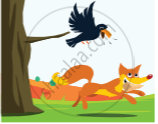Advertisements
Advertisements
प्रश्न
Read the passage and colour one flag each time you read.
Our national emblem is taken from Ashoka’s pillar at Sarnath. It is found on all government documents, coins, currency notes, postcards, and envelopes. It consists of four lions standing back to back but, we can see only three lions at a time. There is a Dharma chakra in the centre of the base plate, with the figure of a bull in the right and that of a horse in the left. The entire structure is sitting on a lotus. The words ‘Sathyameva Jayate’ is written under it in Devanagari script. These words mean, ‘Truth alone Triumphs’.

उत्तर
Do it yourself.
APPEARS IN
संबंधित प्रश्न
Read the text below and summarise it.
The Great Desert Where Hippos Once Wallowed
The Sahara sets a standard for dry land. It’s the world’s largest desert. Relative humidity can drop into the low single digits. There are places where it rains only about once a century. There are people who reach the end of their lives without ever seeing water come from the sky.
Yet beneath the Sahara are vast aquifers of fresh water, enough liquid to fill a small sea. It is fossil water, a treasure laid down in prehistoric times, some of it possibly a million years old. Just 6,000 years ago, the Sahara was a much different place.
It was green. Prehistoric rock art in the Sahara shows something surprising: hippopotamuses, which need year-round water.
“We don’t have much evidence of a tropical paradise out there, but we had something perfectly liveable,” says Jennifer Smith, a geologist at Washington University in St Louis.
The green Sahara was the product of the migration of the paleo-monsoon. In the same way that ice ages come and go, so too do monsoons migrate north and south. The dynamics of earth’s motion are responsible. The tilt of the earth’s axis varies in a regular cycle — sometimes the planet is more tilted towards the sun, sometimes less so. The axis also wobbles like a spinning top. The date of the earth’s perihelion — its closest approach to the sun — varies in cycle as well.
At times when the Northern Hemisphere tilts sharply towards the sun and the planet makes its closest approach, the increased blast of sunlight during the north’s summer months can cause the African monsoon (which currently occurs between the Equator and roughly 17°N latitude) to shift to the north as it did 10,000 years ago, inundating North Africa.
Around 5,000 years ago the monsoon shifted dramatically southward again. The prehistoric inhabitants of the Sahara discovered that their relatively green surroundings were undergoing something worse than a drought (and perhaps they migrated towards the Nile Valley, where Egyptian culture began to flourish at around the same time).
“We’re learning, and only in recent years, that some climate changes in the past have been as rapid as anything underway today,” says Robert Giegengack, a University of Pennsylvania geologist.
As the land dried out and vegetation decreased, the soil lost its ability to hold water when it did rain. Fewer clouds formed from evaporation. When it rained, the water washed away and evaporated quickly. There was a kind of runaway drying effect. By 4,000 years ago the Sahara had become what it is today.
No one knows how human-driven climate change may alter the Sahara in the future. It’s something scientists can ponder while sipping bottled fossil water pumped from underground.
“It’s the best water in Egypt,” Giegengack said — clean, refreshing mineral water. If you want to drink something good, try the ancient buried treasure of the Sahara.
Staff Writer, Washington Post
How does the poem bring out the elusive nature of happiness in human existence?
Dos and Don'ts for Email Etiquettes. Discuss and add one or two Dos and Don'ts on your own.
| Sr. No. | Dos | Don'ts |
| 1. | Have a clear subject line. | Don’t forget your signature. |
| 2. | Use a professional salutation. | Don’t use humour and sarcasm. |
| 3. | Recheck your e-mail. | Don’t assume the recipient knows what you are talking about. |
| 4. | Keep private material confidential. | Don’t punctuate poorly. |
| 5. | Keep your email short and flawless. Stay concise. | Don't hit 'Reply All'. |
| 6. | Check your attachments before sending them. | Don’t think that no one but the intended recipient will see your email. (No predictions) |
| 7. | Include your name or a signature with additional details and contact information. | Don't forward emails without permission. |
Think about what you do and you must learn to do when you speak. Make a list of such 'Do's' and Don'ts' for yourself.
Discuss the following in group.
What can we do to get rid of bad habits?
List the characters in the story and write a few lines about each of them.
What is the difference between this toy train and a normal train?
Did they find a new country?
Pick and write the adverbs to complete the sentence.

A jackal cheated the crow ______.
What did the library door say?
